Effect of Phase-Change Materials on Laboratory-Made Insoles: Analysis of Environmental Conditions
Abstract
:1. Introduction
2. Materials and Methods
2.1. Preliminary Study
2.2. Study of the Optimal Insole Composite Material and Its Properties
2.3. Verification Tests on the Optimal Sample
3. Results and Discussion
3.1. Previous Characterization of the Material
3.2. Optimization of the PCM Concentration in Orthopedic Insoles
3.3. Behavior of Samples under Real, Prolonged Conditions
4. Conclusions
Author Contributions
Funding
Institutional Review Board Statement
Informed Consent Statement
Data Availability Statement
Acknowledgments
Conflicts of Interest
References
- Yick, K.; Yu, A.; Li, P. Insights into footwear preferences and insole design to improve thermal environment of footwear. Int. J. Fash. Des. Technol. Educ. 2019, 12, 325–334. [Google Scholar] [CrossRef]
- Ribezzo, A.; Falciani, G.; Bergamasco, L.; Fasano, M.; Chiavazzo, E. An overview on the use of additives and preparation procedure in phase change materials for thermal energy storage with a focus on long term applications. J. Energy Storage 2022, 53, 105140. [Google Scholar] [CrossRef]
- Delgado, J.; Martinho, J.C.; Vaz Sá, A.; Guimarães, A.S.; Abrantes, V. Thermal Energy Storage with Phase Change Materials; Springer Briefs in Applied Sciences and Technology. Springer: Berlin/Heidelberg, Germany, 2019; ISSN 2191-5318. [Google Scholar] [CrossRef]
- Gilart, P.M.; Martínez, Á.Y.; Barriuso, M.G.; Martínez, C.M. Development of PCM/carbon-based composite materials. Sol. Energy Mater. Sol. Cells 2012, 107, 205–211. [Google Scholar] [CrossRef]
- Gao, Y.; Zhang, W.; Han, N.; Zhang, X.; Li, W. Cotton fabric containing photochromic microcapsules combined thermal energy storage features. Colloids Surf. Phys. Eng. Asp. 2022, 648, 129249. [Google Scholar] [CrossRef]
- Larciprete, M.C.; Paoloni, S.; Cesarini, G.; Sibilia, C.; Rubežienė, V.; Sankauskaitė, A. Thermo-regulating properties of textiles with incorporated microencapsulated Phase Change Materials. MRS Adv. 2020, 5, 1023–1028. [Google Scholar] [CrossRef]
- Raza, S.M.O.; Zehra, B.; Usama, N.M.; Kashif, I.; Muhammad, Z.; Danmei, S. Modelling method to evaluate the thermo-regulating behaviour of micro-encapsulated PCMs coated fabric. Ind. Text. 2022, 73, 3–11. [Google Scholar] [CrossRef]
- West, A.M.; Schönfisch, D.; Picard, A.; Tarrier, J.; Hodder, S.; Havenith, G. Shoe microclimate: An objective characterisation and subjective evaluation. Appl Erg. 2019, 78, 1–12. [Google Scholar] [CrossRef] [Green Version]
- Li, P.; Yick, K.; Yip, J.; Ng, S. Influence of Upper Footwear Material Properties on Foot Skin Temperature, Humidity and Perceived Comfort of Older Individuals. Int. J. Environ. Res. Public Health 2022, 19, 10861. [Google Scholar] [CrossRef]
- Nemati, H.; Naemi, R. An Analytical Model to Predict Foot Sole Temperature: Implications to Insole Design for Physical Activity in Sport and Exercise. Appl. Sci. 2022, 12, 6806. [Google Scholar] [CrossRef]
- Ning, K.; Yick, K.; Yu, A.; Yip, J. Effects of textile-fabricated insole on foot skin temperature and humidity for enhancing footwear thermal comfort. Appl. Erg. 2022, 104, 103803. [Google Scholar] [CrossRef]
- Ferraz, J.; Silva, S.; Fernandes, H.; Bogas, S.; Vale, B.; Gonçalves, J.; Matos, C.; Pedrosa, R.; Leite, T. Active Thermal Regulation Systems for Footwear: Development of New Innovative Technologies, Key Engineering Materials; Trans Tech Publications Ltd.: Bäch, Switzerland, 2021; pp. 57–63. [Google Scholar]
- Greszta, A.; Bartkowiak, G.; Dąbrowska, A.; Gliścińska, E.; Machnowski, W.; Kozikowski, P. Multilayer Nonwoven Inserts with Aerogel/PCMs for the Improvement of Thermophysiological Comfort in Protective Clothing against the Cold. Materials 2022, 15, 2307. [Google Scholar] [CrossRef]
- Dai, J.; Peng, Y.; Teng, N.; Liu, Y.; Liu, C.; Shen, X.; Mahmud, S.; Zhu, J.; Liu, X. High-performing and fire-resistant biobased epoxy resin from renewable sources. ACS Sustain. Chem. Eng. 2018, 6, 7589–7599. [Google Scholar] [CrossRef]
- Oldring, P.K. Coatings, colorants, and paints. In Encyclopedia of Physical Science and Technology; Academic Press: Ann Arbor, MI, USA, 2003; pp. 175–190. [Google Scholar]
- Chikhi, N.; Fellahi, S.; Bakar, M. Modification of epoxy resin using reactive liquid (ATBN) rubber. Eur. Polym. J. 2002, 38, 251–264. [Google Scholar] [CrossRef]
- Kojnoková, T.; Nový, F.; Markovičová, L. The Study of Chemical and Thermal Influences of the Environment on the Degradation of Mechanical Properties of Carbon Composite with Epoxy Resin. Polymers 2022, 14, 3245. [Google Scholar] [CrossRef]
- Yang, J.; He, X.; Wang, H.; Liu, X.; Lin, P.; Yang, S.; Fu, S. High-toughness, environment-friendly solid epoxy resins: Preparation, mechanical performance, curing behavior, and thermal properties. J. Appl. Polym. Sci. 2020, 137, 48596. [Google Scholar] [CrossRef]
- Kenny, R.P.; Atkinson, G.; Eaves, D.L.; Martin, D.; Burn, N.; Dixon, J. The effects of textured materials on static balance in healthy young and older adults: A systematic review with meta-analysis. Gait Posture 2019, 71, 79–86. [Google Scholar] [CrossRef]
- Martínez-Nova, A.; Jiménez-Cano, V.M.; Caracuel-López, J.M.; Gómez-Martín, B.; Escamilla-Martínez, E.; Sánchez-Rodríguez, R. Effectiveness of a central discharge element sock for plantar temperature reduction and improving comfort. Int. J. Environ. Res. Public Health 2021, 18, 6011. [Google Scholar] [CrossRef]
- Bezerra, M.A.; Santelli, R.E.; Oliveira, E.P.; Villar, L.S.; Escaleira, L.A. Response surface methodology (RSM) as a tool for optimization in analytical chemistry. Talanta 2008, 76, 965–977. [Google Scholar] [CrossRef]
- Phase Change Material. Available online: https://www.rubitherm.eu/en/index.php/productcategory/organische-pcm-rt (accessed on 21 July 2022).
- Box, G.B.D. Simple-sum designs—A class of 2nd rotatable designs derivable of those of 1st order. Ann. Math. Stat. 1960, 4, 838–864. [Google Scholar] [CrossRef]
- Ferreira, S.C.; Bruns, R.E.; Ferreira, H.S.; Matos, G.D.; David, J.M.; Brandão, G.C.; da Silva, E.P.; Portugal, L.A.; Dos Reis, P.S.; Souza, A.S. Box-Behnken design: An alternative for the optimization of analytical methods. Anal. Chim. Acta 2007, 597, 179–186. [Google Scholar] [CrossRef]
- Isherwood, J.; Rimmer, E.; Fu, F.; Xie, Z.; Sterzing, T. Biomechanical and perceptual cushioning sensitivity based on mechanical running shoe properties. Footwear Sci. 2021, 13, 221–231. [Google Scholar] [CrossRef]
- Shim, D.W.; Sung, S.; Chung, W.; Kang, K.; Park, S.; Lee, J.W.; Chae, D.S. Superior pedal function recovery of newly designed three spike insole over total contact insole in refractory plantar fasciitis: A randomized, double-blinded, non-inferiority study. PLoS ONE 2021, 16, e0255064. [Google Scholar] [CrossRef] [PubMed]
- Álvarez Feijoo, M.Á.; Arce Fariña, M.E.; Suárez-García, A.; González-Peña, D.; Díez-Mediavilla, M. Compounds with epoxy resins and phase change materials for storage in solar applications. Materials 2019, 12, 3522. [Google Scholar] [CrossRef] [PubMed] [Green Version]
- Arce, E.; Agrawal, R.; Suárez, A.; Febrero, L.; Luhrs, C.C. Modeling of energy demand and savings associated with the use of epoxy-phase change material formulations. Materials 2020, 13, 639. [Google Scholar] [CrossRef] [PubMed] [Green Version]
- Cheng, P.; Wei, K.; Shi, W.; Shi, J.; Wang, S.; Ma, B. Preparation and performance analysis of phase change microcapsule/epoxy resin composite phase change material. J. Energy Storage 2022, 47, 103581. [Google Scholar] [CrossRef]
- Borreguero, A.M.; Talavera, B.; Rodriguez, J.F.; Valverde, J.L.; Gonzalez, J.L.; Carmona, M. Enhancing the thermal comfort of fabrics for the footwear industry. Text. Res. J. 2013, 83, 1754–1763. [Google Scholar] [CrossRef]
- Bonadies, I.; Izzo Renzi, A.; Cocca, M.; Avella, M.; Carfagna, C.; Persico, P. Heat storage and dimensional stability of poly (vinyl alcohol) based foams containing microencapsulated phase change materials. Ind. Eng. Chem. Res. 2015, 54, 9342–9350. [Google Scholar] [CrossRef]
- Miao, T.; Li, Y. Modelling the thermal microenvironment of footwear subjected to forced ventilation. Ergonomics 2022. [Google Scholar] [CrossRef]
- Miao, T.; Wang, P.; Zhang, N.; Li, Y. Footwear microclimate and its effects on the microbial community of the plantar skin. Sci. Rep. 2021, 11, 20356. [Google Scholar] [CrossRef]
- Ismail, K.A.; Lino, F.A.; Machado, P.L.O.; Teggar, M.; Arıcı, M.; Alves, T.A.; Teles, M.P. New potential applications of phase change materials: A review. J. Energy Storage 2022, 53, 105202. [Google Scholar] [CrossRef]
- Wu, J.; Wang, M.; Dong, L.; Zhu, C.; Shi, J.; Morikawa, H. Ultraflexible, Breathable, and Form-Stable Phase Change Fibrous Membranes by Green Electrospinning for Personal Thermal Management. ACS Sustain. Chem. Eng. 2022, 10, 7873–7882. [Google Scholar] [CrossRef]
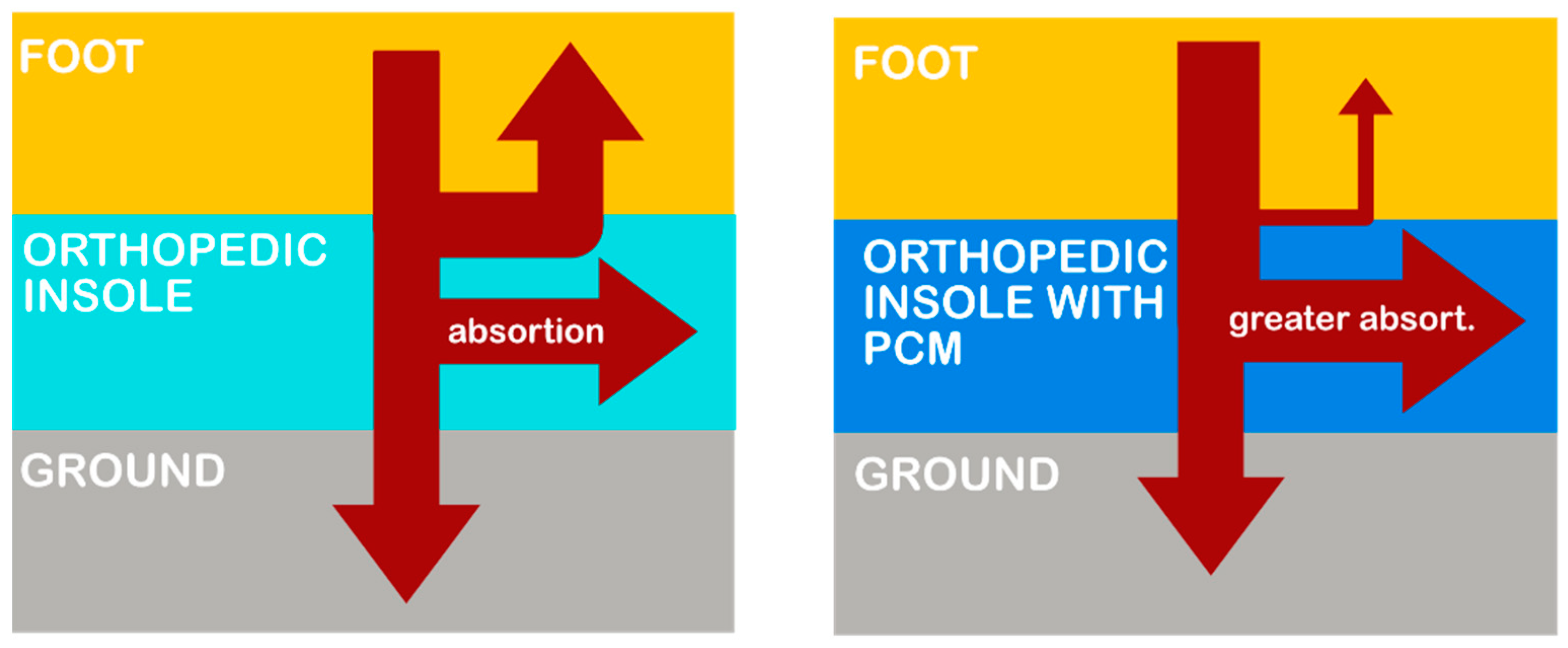
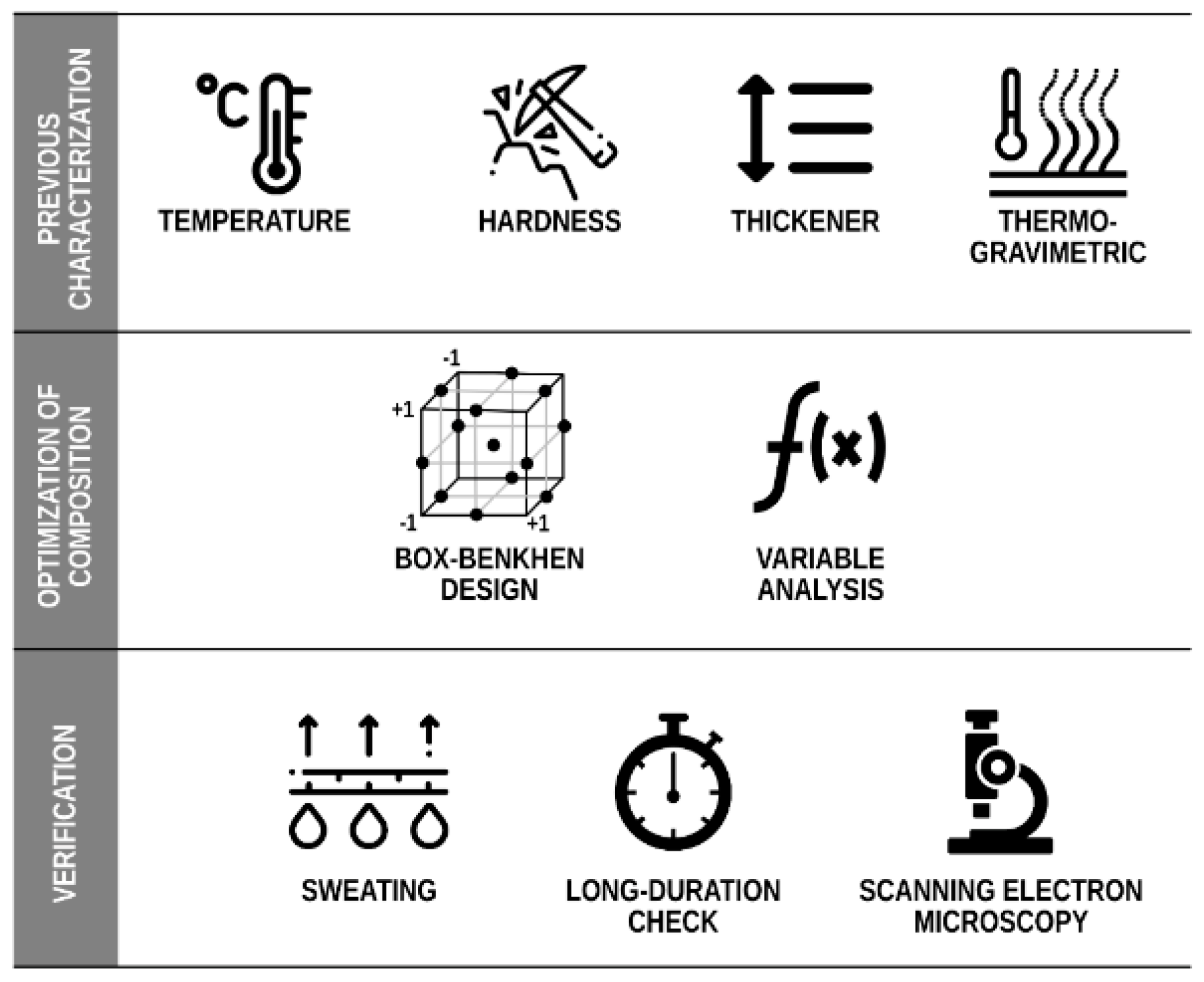
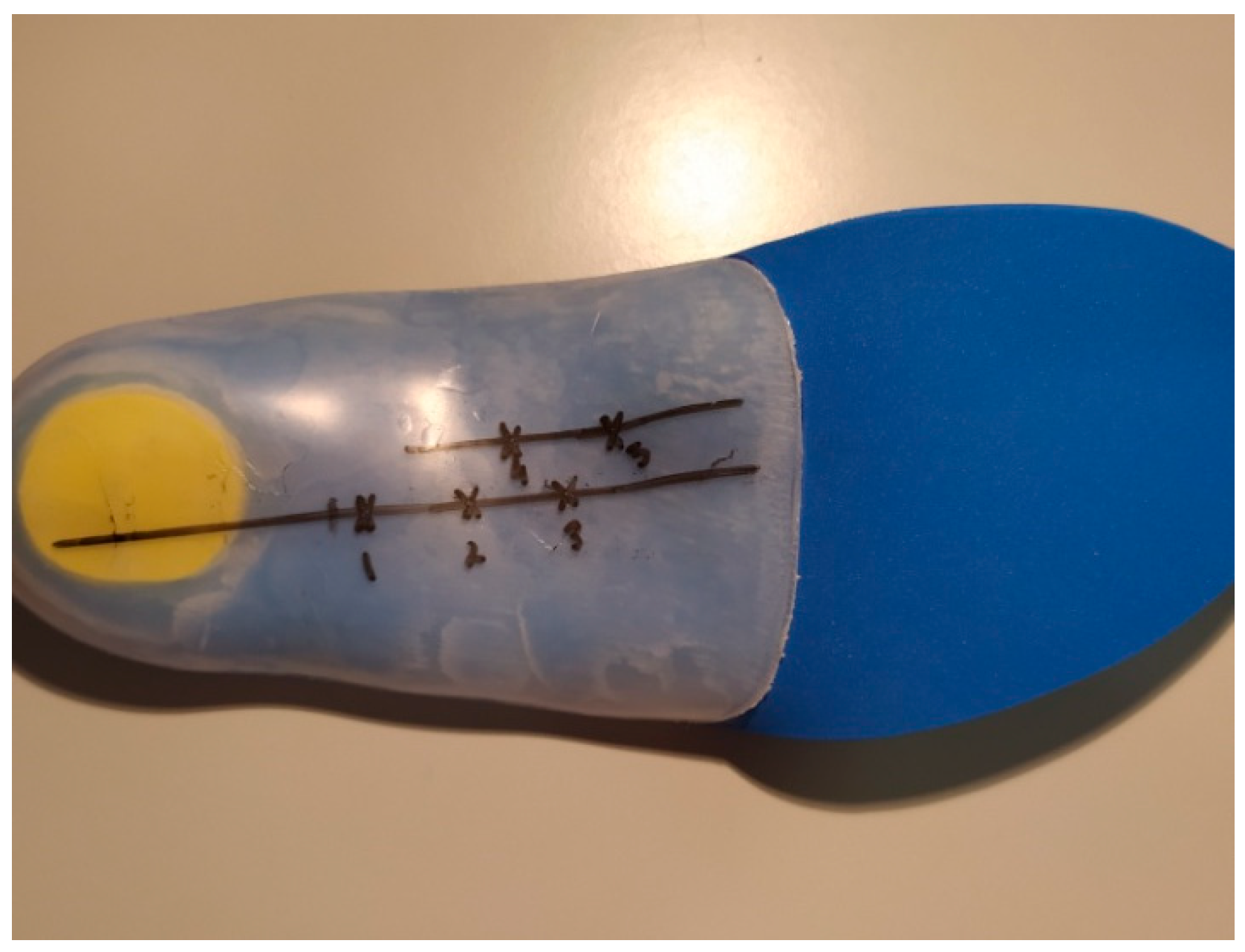
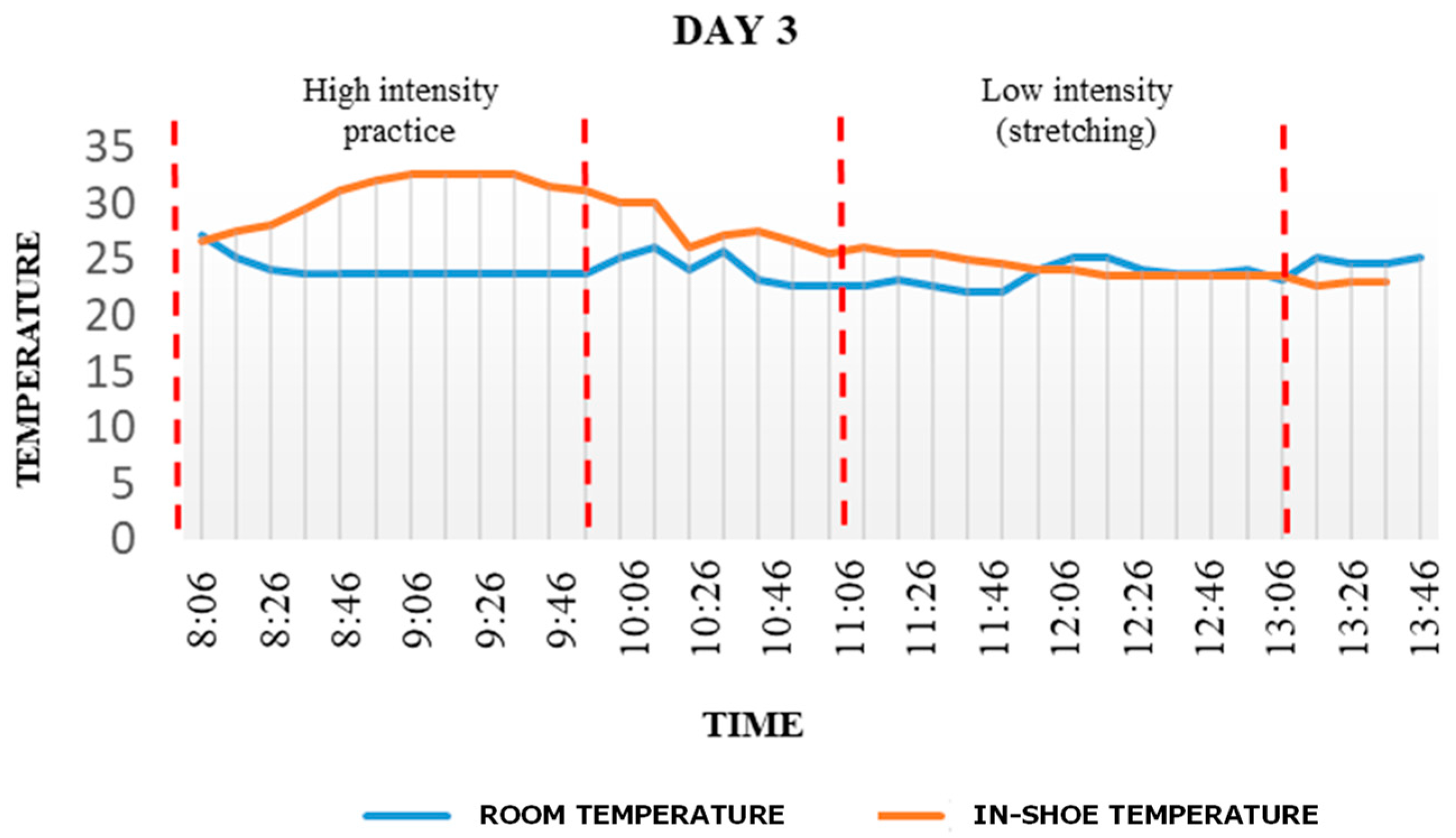
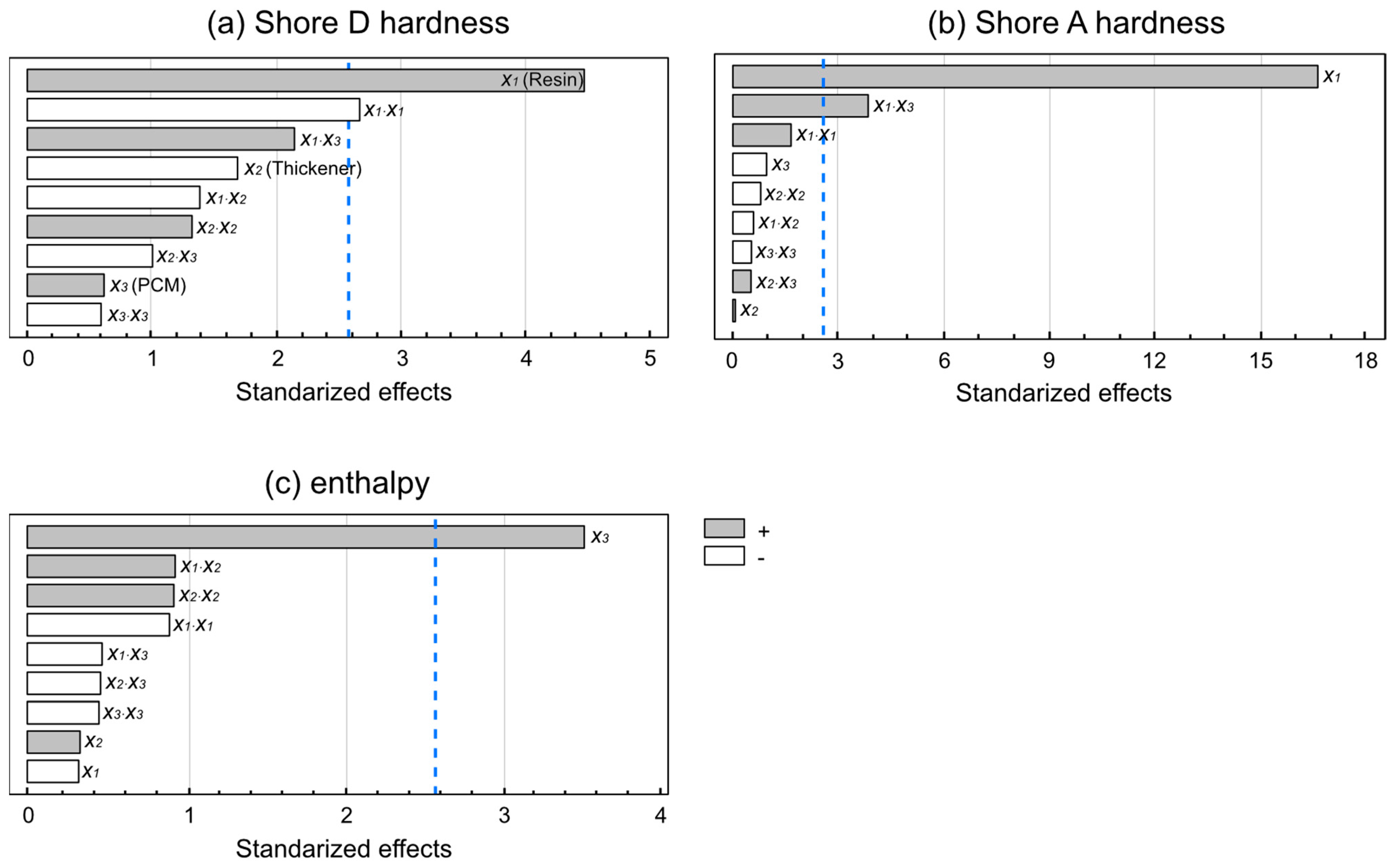
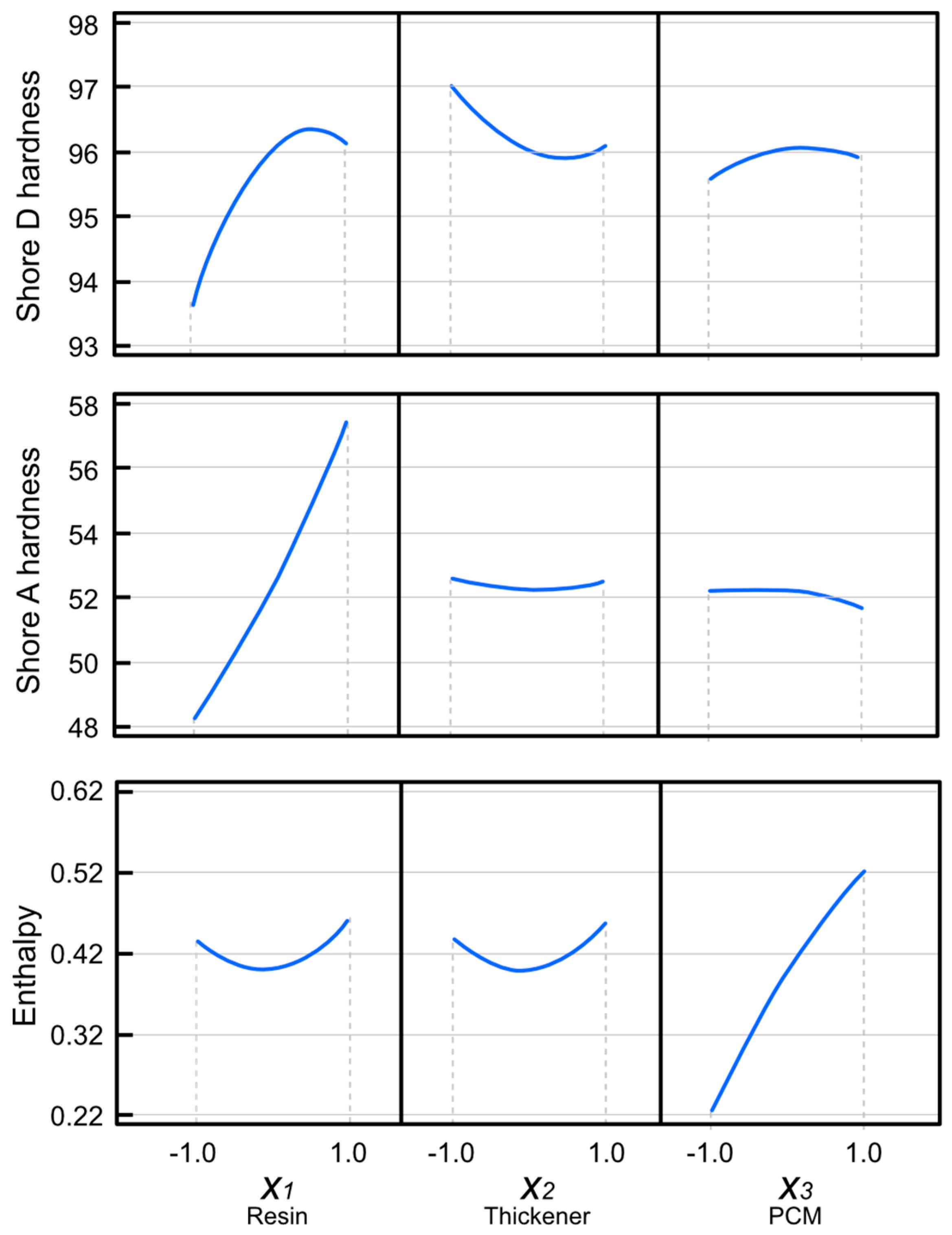
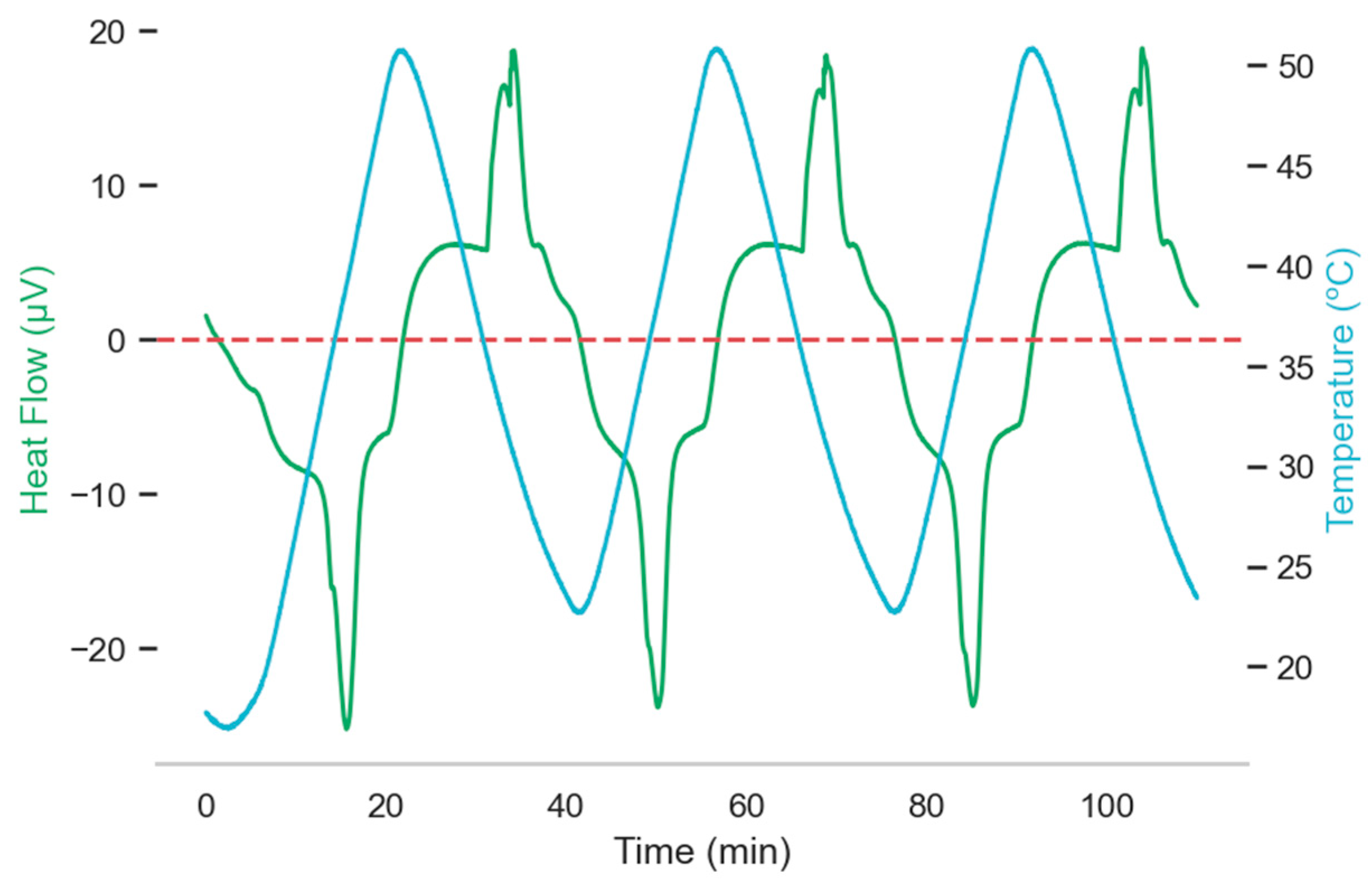

| Sampling Point | Insole 1 | Insole 2 | Insole 3 |
|---|---|---|---|
| 1. | 45 | 48 | 57 |
| 2. | 55 | 51 | 67 |
| 3. | 57 | 54 | 68 |
| 4. | 54 | 55 | 65 |
| 5. | 51 | 47 | 61 |
| Mean value | 52.4 | 51 | 63.6 |
| CV (%) | 8.9 | 6.9 | 7.2 |
| (a) Independent Variables | |||
| Variable | Nomenclature | Units | Range of Variation |
| Resin (1050) | [R] | % | (20, 40) |
| Thickener | [T] | g | (0.3, 0.5) |
| PCM | [PCM] | g | (1, 2) |
| (b) Dimensionless, Coded Independent Variables | |||
| Variable | Nomenclature | Definition | Variation Range |
| Dimensionless resin | x1 | ([R] – 30)/10 | (–1, 1) |
| Dimensionless thickener | x2 | ([T] – 0.4)/0.1 | (–1, 1) |
| Dimensionless PCM | x3 | ([PCM]–1.5)/0.5 | (–1, 1) |
| (c) Dependent Variables | |||
| Variable | Nomenclature | Units | |
| Shore D hardness | y1 | Shore D | |
| Shore A hardness | y2 | Shore A | |
| Absorbed heat | y3 | µV/mg | |
| Independent Variables | Dependent Variables | |||||
|---|---|---|---|---|---|---|
| Exp. | x1 | x2 | x3 | y1 | y2 | y3 |
| 1 | −1 | −1 | 0 | 49 | 93.4 | 0.5145 |
| 2 | −1 | 1 | 0 | 49 | 94.6 | 0.4774 |
| 3 | 1 | −1 | 0 | 58 | 97.4 | 0.4416 |
| 4 | 1 | 1 | 0 | 57 | 96.4 | 0.6115 |
| 5 | −1 | 0 | −1 | 49 | 94 | 0.3126 |
| 6 | −1 | 0 | 1 | 46.2 | 93.2 | 0.5020 |
| 7 | 1 | 0 | −1 | 56 | 94.4 | 0.3723 |
| 8 | 1 | 0 | 1 | 59.4 | 97 | 0.5243 |
| 9 | 0 | −1 | −1 | 53 | 97.6 | 0.1893 |
| 10 | 0 | −1 | 1 | 51.2 | 95.8 | 0.6708 |
| 11 | 0 | 1 | −1 | 53 | 95.6 | 0.1970 |
| 12 | 0 | 1 | 1 | 52 | 94.8 | 0.6211 |
| 13 | 0 | 0 | 0 | 52.2 | 96 | 0.3884 |
| 14 | 0 | 0 | 0 | 52.2 | 96 | 0.438 |
| 15 | 0 | 0 | 0 | 52.2 | 96 | 0.4188 |
| Resin (%) | Thickener (g) | PCM (g) | Predicted Shore D Hardness Values |
| 0.0 | 0.0 | 0.0000 | 96.0 |
| 1.0 | −2.1377 | 0.9338 | 102.392 |
| 2.0 | −6.2131 | 2.3701 | 134.047 |
| 3.0 | −10.4371 | 3.7829 | 194.466 |
| 4.0 | −14.6997 | 5.1868 | 283.881 |
| 5.0 | −18.9797 | 6.5861 | 401.386 |
| Resin (%) | Thickener (g) | PCM (g) | Predicted Shore A Hardness Values |
| 0.0 | 0.0 | 0.0000 | 52.2 |
| 1.0 | −0.02299 | 0.07579 | 57.651 |
| 2.0 | −0.07504 | 0.3413 | 65.271 |
| 3.0 | −0.1416 | 0.7052 | 75.508 |
| 4.0 | −0.2161 | 1.1243 | 88.535 |
| 5.0 | −0.2953 | 1.5771 | 104.431 |
| Resin (%) | Thickener (g) | PCM (g) | Predicted Enthalpy Values |
| 0.0 | 0.0 | 0.0000 | 0.4 |
| 1.0 | 1.0 | 8.2553 | −0.303 |
| 2.0 | 2.0 | 16.3357 | −4.805 |
| 3.0 | 3.0 | 24.5669 | −13.267 |
| 4.0 | 4.0 | 32.8108 | −25.654 |
| 5.0 | 5.0 | 41.0529 | −41.964 |
| Shore D Hardness | ||
| Factor | Optimum value (coded) | Optimum value (uncoded) |
| Resin | 0.9999 | ~40 |
| Thickener | −0.9703 | 0.48 |
| PCM | 1.0 | 2 |
| Shore A Hardness | ||
| Factor | Optimum value (coded) | Optimum value (uncoded) |
| Resin | 1.0000 | 40 |
| Thickener | −1.0000 | 0.3 |
| PCM | 0.9994 | ~2 |
| Enthalpy | ||
| Factor | Optimum value (coded) | Optimum value (uncoded) |
| Resin | −1.0 | 20 |
| Thickener | −1.0 | 0.3 |
| PCM | 0.9522 | 1.9 |
Publisher’s Note: MDPI stays neutral with regard to jurisdictional claims in published maps and institutional affiliations. |
© 2022 by the authors. Licensee MDPI, Basel, Switzerland. This article is an open access article distributed under the terms and conditions of the Creative Commons Attribution (CC BY) license (https://creativecommons.org/licenses/by/4.0/).
Share and Cite
Arce, E.; Devesa-Rey, R.; Suárez-García, A.; González-Peña, D.; García-Fuente, M. Effect of Phase-Change Materials on Laboratory-Made Insoles: Analysis of Environmental Conditions. Materials 2022, 15, 6967. https://doi.org/10.3390/ma15196967
Arce E, Devesa-Rey R, Suárez-García A, González-Peña D, García-Fuente M. Effect of Phase-Change Materials on Laboratory-Made Insoles: Analysis of Environmental Conditions. Materials. 2022; 15(19):6967. https://doi.org/10.3390/ma15196967
Chicago/Turabian StyleArce, Elena, Rosa Devesa-Rey, Andrés Suárez-García, David González-Peña, and Manuel García-Fuente. 2022. "Effect of Phase-Change Materials on Laboratory-Made Insoles: Analysis of Environmental Conditions" Materials 15, no. 19: 6967. https://doi.org/10.3390/ma15196967





